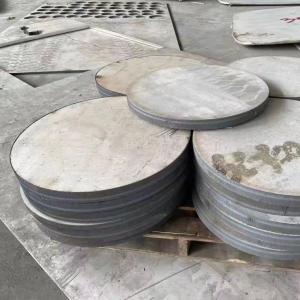316Ti Stainless Steel Plate Laser Cutting Stainless Steel 1.4571 / S31635 Stainless Plate
Add to Cart

316Ti Stainless Steel Plate Laser Cutting Stainless Steel 1.4571 / S31635 Stainless Plate
| Products Name | Stainless Steel Plate Sheet |
| Grade | 316Ti / S31635 / 1.4571 |
| Thickness range | cold rolled 0.6 - 3.0mm , hot rolled 4.0 - 30.0mm |
| Standard size | cold rolled 1219*2438mm hot rolled 1500*6000mm |
| Standard | ASTM A240 / JIS G4305 / EN 10088-2 |
| Brand | TISCO POSCO JISCO LISCO DONGTE BAOSTEEL |
| MOQ | 1 PCS |
| Service | Cutting Surface Finishing (BA 8K HL colored Checkered) |
Introduce about 316Ti stainless steel
Stainless steel types 1.4401 and 1.4404 are also known as grades
316 and 316L respectively. Grade 316 is an austenitic grade second
only to 304 in commercial importance. 316 stainless steel contains
an addition of molybdenum that gives it improved corrosion
resistance. This is particularly apparent for pitting and crevice
corrosion in chloride environments. 316L, the low carbon version of
316 stainless steel, is immune to grain boundary carbide
precipitation (sensitisation). This makes it suited to use in heavy
gauge (over about 6mm) welded components. For elevated temperature
applications the high carbon variant, 316H stainless steel and the
stabilised grade 316Ti stainless steel should be employed. The
austenitic structure of 316 stainless steel gives excellent
toughness, even at cryogenic temperatures. Property data given in
this document is typical for flat rolled products covered by ASTM
A240/A240M. ASTM, EN or other standards may cover products sold. It
is reasonable to expect specifications in these standards to be
similar but not necessarily identical to those given in this
datasheet.
Stainless steel grade 316Ti contains a small amount of titanium.
Titanium content is typically only around 0.5%. The titanium atoms
stabilise the structure of the 316 at temperatures over 800°C. This
prevents carbide precipitation at the grain boundaries and protects
the metal from corrosion. The main advantage of 316Ti is that it
can be held at higher temperatures for a longer period without
sensitisation (precipitation) occurring. 316Ti retains physical and
mechanical properties similar to standard grades of 316.
Chemical Composition of 316Ti stainless steel
| 316Ti (1.4571) Chemical Composition | |||||||||
| Grade | C | Mn | P | S | Si | Cr | Ni | Mo | Ti |
| 316Ti (1.4571) | 0.08max | 2.0 | 0.045 | 0.030 | 1.0 | 16.0-18.0 arası | 10.0- 14.0 arası | 2.0-3.0 arası | 0.70 max |
Application of 316Ti Stainless Steel
Food processing equipment
Brewery equipment
Chemical and petrochemical equipment
Laboratory benches & equipment
Coastal architectural panelling
Coastal balustrading
Boat fittings
Chemical transportation containers
Heat exchangers
Mining screens
Why Choose 316Ti Stainless Steel
It is common to find a connection to a German equipment manufacturer or design. However, 316Ti is practically non-existent in North American inventory, and usually requires a mill production run.
Titanium is used as a stabilizing element in austenitic stainless steels with higher carbon contents, and will reduce the formation of chromium carbides. It can improve the aqueous corrosion resistance of welds made in higher carbon grades. Actually, 316Ti is a derivative of 316 in the same way that 321 is related to 304. In fact, 321 is the titanium stabilized version of 304, but while 321 is common in the petrochemical and aerospace industries, 316Ti is not.
The reason for the popularity of 316Ti in Europe is really an historical one. 316Ti exists as the preferred material in many specifications that have not been changed in years - it is basically Germany and the Eastern European countries that keep the grade alive. Regions to the west, south and north of Germany have since long changed to mainly using 316/316L for chemical process and aqueous corrosion applications.
| DAVs ASME Sec VIII Div 1 | ||||
| 500° F | 850° F | 1200° F | 1500° F | |
| 316L | 10.9 | 9.4 | NP | NP |
| 316 | 13.3 | 11.6 | 7.4 | 1.3 |
| 316Ti | 13.2 | 11.7 | 7.4 | 1.3 |
| 316H | 13.3 | 11.6 | 7.4 | 1.3 |
Although it can have a higher carbon content, there seems to be no mechanical property advantage to 316Ti since there is no difference in minimum yield stress for the three variations 316/1.4401, 316L/1.4404, 316Ti/1.4571 in any of the basic EN standards, EN 10088-2 (General application), EN 10088-4 (Structural application) and 10028-7 (Pressure vessel application). In all three Euronorms, the Rp0.2 (YS) is listed as minimum 220 MPa (32 KSI) for plate. In ASTM standards there is a slightly lower YS for 316L (25 KSI) versus 316 and 316Ti (30 KSI), but since nearly all 316L is dual certified as 316, there is no practical difference. The ASME Section VIII Design Allowable Values (DAV) for 316, 316H and 316Ti are the same all the way through the maximum permitted temperature of 1500° F. Note that this is due, in part, to the requirement that any austenitic stainless used at 1000° F or higher must have 0.04% minimum carbon.
In the final analysis, for typical aqueous corrosion applications, there is no advantage to 316Ti over dual certified 316/316L. For high temperature service (above 1000° F), there is no advantage in using 316Ti compared to 316H. There may be a few situations where equipment can see both elevated temperature service and occasional aqueous corrosion issues where a stabilized grade is warranted. Processes in the petroleum refining industry that can encounter these conditions include catalytic cracking and hyrdodesulfurization. In these areas, the corrosion resistance of 321 is adequate. If the anticipated aqueous corrosion is too severe for 321, it is more common to consider alloys like Alloy 20 or 825, which are much more readily available in North America.

